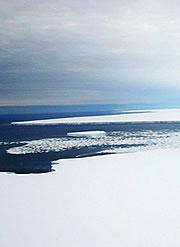 B-15A slides majestically across the horizon. Click
B-15A slides majestically across the horizon. Click It was hailed as a harbinger of global warming; it caused a glacial hit-and-run smash; it even terrorized a hapless group of penguins. And now, it has been revealed that the death of the world's most infamous modern-day iceberg was likewise worthy of a Hollywood film — it was broken up by a storm surge that swept the entire length of the Pacific Ocean.
Glaciologists studying the gigantic B-15A iceberg, which broke up in October 2005, have discovered that it fragmented as it was being buffeted by a wave whipped up by a violent storm in the Gulf of Alaska six days before.
The swell travelled a staggering 13,500 kilometres before reaching the iceberg, which measured some 100 by 30 kilometres and was floating just off Cape Adare, at the tip of Antarctica's Victoria Land region.
Music of icebergs
Researchers led by Douglas MacAyeal of the University of Chicago spotted the event more or less by chance — they had deployed seismic sensors in the area to capture the low-frequency murmurings nicknamed the 'music of icebergs', but the equipment was sensitive enough to spot the slower, gentler vibrations of a storm swell that pulled apart the creaking wreck.
By comparing the arrival times of faster and slower-moving wavelengths of the swell, the team calculated the storm responsible had, surprisingly, originated almost on the far side of the globe. Buoy measurements confirmed that 10 metre-tall waves were spotted in the Gulf of Alaska during its storm, and 5 metre waves showed up in Hawaii two days after that. The researchers report their discovery in the journal Geophysical Research Letters1.
The new result may shed some light on how giant cracks form in glacial ice — the same process by which mega-bergs are initially unleashed from ice shelves, says glaciologist David Vaughan of the British Antarctic Survey in Cambridge, UK. "How they form is the same as how they break up," he explains.
Live famous, die famous
 Animation of the collision between B-15A iceberg and Drygalski ice tongue.ESA
Animation of the collision between B-15A iceberg and Drygalski ice tongue.ESAIt's a fitting end to a life spent in the scientific and media spotlight. B-15A's parent iceberg, a gigantic mountain of ice the size of Jamaica called B-15, was born in March 2000. It broke off from the Ross Ice Shelf, a huge plateau of frozen snow several hundred metres thick that faces out from Antarctica's edge.
After drifting in the Ross Sea for a couple of years, B-15 split into several daughter icebergs. As the biggest of these daughters, B-15A inherited its title of the largest floating object on the planet.
The iceberg drifted calmly for a couple more years before disaster loomed: in January 2005 it became clear that prevailing currents had placed it on a collision course with the Drygalski Ice Tongue, a glacial run-off that juts from the nearby coastline.
The iceberg then seemed to run aground, reducing the strength of the impact (see 'Giant iceberg grinds to a halt'). But eventually, on 15 April 2005, the crunching collision occurred, breaking off the tip of the ice tongue and halting B-15A's stately progress.
Penguin blocker
Worse was to follow. Now beached on the coast, the berg was blocking the summer winds and currents that help sea ice to melt in McMurdo Sound, thus preventing supply ships from serving the region's three research stations.
ADVERTISEMENT
Researchers also worried that the block would cause problems for Adelie penguins nesting in the area, giving them an arduous round-trip to the sea to find food for the young in their nests.
Eventually, however, the sea currents wrestled B-15A from its mooring and out into the open sea, where it met its violent end.
It's unclear whether the appearance of such giant icebergs as B-15A really are a sign of global warming, Vaughan adds. "Big icebergs form so infrequently that it's hard to say," he says. "It definitely happens in cycles, and the Ross Ice Shelf hasn't produced big icebergs for many years."
Visit our oftheworldsmost_famo.html">newsblog to read and post comments about this story.
